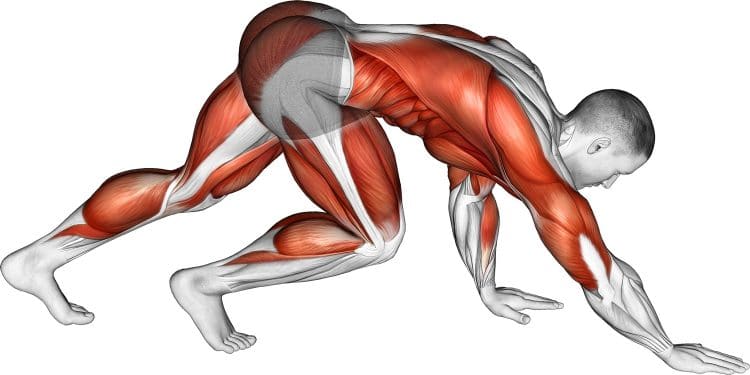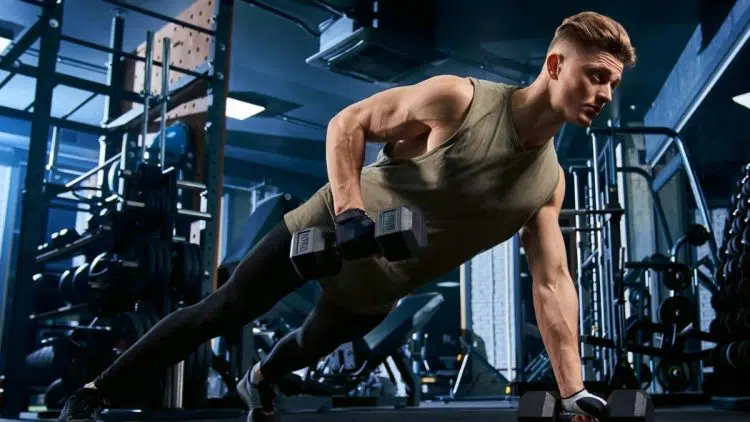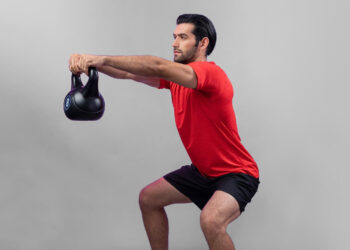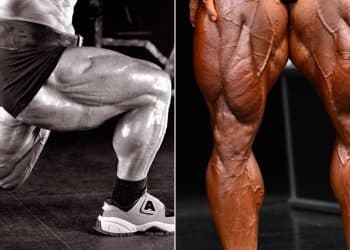Walking upright is a very energy-efficient activity. That’s why you can walk for miles and miles without getting tired. Your center of gravity is balanced over your base of support, which means very little muscle engagement is required to keep you standing.
However, that all changes when you move on to all fours. Your weight is no longer just over your feet, and you’ll have to work much harder to move over the ground. Animals make walking on all fours look easy, but it is much more demanding for us humans.
While you might not want to purposely crawl on all fours to get from point A to point B, there are crawling exercises that you can use to develop fitness and core strength. One of the best is the bear crawl.
In this article, we explain why and how to bear crawl and reveal some of the best variations and alternatives. We’ve also included a bear crawl-based workout to try.
Bear Crawl – Muscles Worked
Like walking upright, bear crawls work a large number of muscles. That’s what makes this such an effective if challenging exercise. It’s probably best to think of bear crawls as being a full-body exercise. That said, the main muscles you’ll be using during bear crawls are:

Core
The collective term for the muscles of your midsection, your core muscles contract or brace to stabilize your lumbar spine during bear crawls. If you aren’t feeling this exercise in your core, you probably aren’t doing it right. The main core muscles are the rectus abdominis, obliques, transverse abdominis, and erector spinae.
Level Up Your Fitness: Join our 💪 strong community in Fitness Volt Newsletter. Get daily inspiration, expert-backed workouts, nutrition tips, the latest in strength sports, and the support you need to reach your goals. Subscribe for free!
Deltoids
Supporting your weight on your hands and feet means your shoulders are going to get a great workout during bear crawls. Of the three deltoids (anterior/front, medial/middle, and posterior/rear), the anterior deltoids are the most active.
Pectoralis major
Working with your deltoids, your pecs are very active during bear crawls. You’ll need to use your chest muscles to stabilize your upper arms and propel you forward.
Triceps
Located on the back of your upper arm, you’ll definitely feel your triceps working during bear crawls. Your triceps must stay contracted to stop your arms from collapsing under your weight.
Quadriceps
Done correctly, your knees should remain bent at about 90 degrees during bear crawls. This means your quadriceps, located on the front of your thighs, need to work to support your weight as you move forward and back.
Hip flexors
Located on the front of your hips, the hip flexors work with your core to stabilize your pelvis during bear crawls. In addition, you’ll be using your hip flexors to move your legs forward as you move.
Cardiovascular system
Because bear crawls involve lots of muscles and an awkward movement, they’re good for developing cardiovascular fitness. Your heart and breathing rate will soon increase as your body works harder to supply oxygen to the working muscles. Bear crawls are an excellent metabolic conditioning (met-con) exercise.
How to Do Bear Crawls
Get more from bear crawls while keeping your risk of injury to a minimum by following these guidelines:
- Kneel down on all fours so your hands are directly under your shoulders and your knees are under your hips. Pull your toes up and press the balls of your feet into the floor.
- Brace your abs, pull your shoulders down and back, and rotate your elbows inward to engage your lats. Your lower back and neck should be neutral. Lift your knees a few inches off the floor while keeping your hips level with your shoulders.
- Without lifting your hips, move your left hand and right foot forward, and then your right hand and left foot.
- Continue crawling forward over the specified distance or number of steps.
- You can also bear crawl backward, sideways, and diagonally.
Bear Crawl Benefits and Drawbacks
Benefits
Not sure if bear crawls are worth adding to your workouts? Consider these benefits and then decide:
Full-body workout – done correctly, bear crawls work almost every major muscle in your body. While not really a bodybuilding exercise, if you want to develop endurance and stability alongside your cardiovascular fitness, bear crawls are an excellent choice.
Anywhere, anytime – all you need for bear crawls is enough space to do them. With no equipment required, bear crawls are perfect for home exercisers and anyone who works out in places like parks or their yard.
A moving plank – while planks are a great core exercise, they are 100% static which reduces their functionality. In contrast, bear crawls involve stabilizing your core as you move your arms and legs. This is a much more functional way to train your core, as this is how your muscles tend to work in nature.
Good for HIIT and circuit training workouts – maintain or even increase your heart rate as you train your core with bear crawls. They’re a tremendous met-con exercise that will work well in all types of workouts, especially HIIT and circuit training.
Drawbacks
While bear crawls are a mostly safe and beneficial exercise, there are also a couple of drawbacks to consider:
Wrist pain – doing bear crawls puts a lot of strain on your wrists. If you have tight forearms or just find bending your wrists backward uncomfortable, bear crawls may be impractical. One way to avoid wrist pain during bear crawls is to use push-up bars, so you can keep your wrists straight.
Hips too high – a lot of people lift their hips above their shoulders during bear crawls. This puts more weight on your hands and also reduces core engagement. Keep your hips down to do bear crawls correctly and get more from this exercise. Lifting your butt is basically cheating!
Level Up Your Fitness: Join our 💪 strong community in Fitness Volt Newsletter. Get daily inspiration, expert-backed workouts, nutrition tips, the latest in strength sports, and the support you need to reach your goals. Subscribe for free!
Not ideal for people with a large stomach – a big belly could make this exercise uncomfortable. Not only will that weight put a lot of stress on your lower back, but it could also stop you from moving your arms and legs comfortably. If you are overweight, try bear crawls, but find them uncomfortable or painful, this may not be the exercise for you.
7 Bear Crawl Variations and Alternatives
Bear crawls are a highly effective core and conditioning exercise, but that doesn’t mean you need to do them all the time. Here are several variations and alternatives that you can use to keep your workouts productive and interesting:
1. Bear crawl plank
No space for bear crawls? Or maybe you need to master stabilizing your core before you start moving your arms and legs? Either way, the bear crawl plank is a good option. This is a very effective core exercise.
How to do it:
- Kneel down on all fours with your hands directly under your shoulders and your knees under your hips. Pull your toes up and press the balls of your feet into the floor. Brace your abs, pull your shoulders down and back, and rotate your arms inward to engage your lats.
- Lift your knees a few inches off the floor while keeping your hips level with your shoulders.
- Maintain this position for the required duration.
- Increase core and especially oblique activation by lifting one hand and the opposite foot off the floor.
2. Bear crawl to push-up
Combine bear crawls with push-ups to train your core and upper body at the same time. This exercise requires very little space, making it ideal for home and hotel room workouts. It’s also easier on your wrists than regular bear crawls.
How to do it:
- Kneel down on all fours with your hands directly under your shoulders and your knees under your hips. Pull your toes up and press the balls of your feet into the floor. Brace your abs, pull your shoulders down and back, and elbows your arms inward to engage your lats.
- Lift your knees a few inches off the floor while keeping your hips level with your shoulders.
- Keeping your upper body stationary and core braced, walk your feet out and back into the push-up position. Bend your arms and do one perfect push-up.
- Taking small steps, walk your feet back and into the bear crawl plank position.
- That’s one rep; keep going!
3. Dumbbell bear crawl
Increase upper back and core engagement by doing bear crawls with a dumbbell in each hand. Use light weights as even small dumbbells will have a significant impact on the difficulty and performance of this exercise. However, you may also find that using dumbbells helps take the stress off your wrist joints.
4. Renegade row + Push-up
Renegade rows work almost the same muscles as bear crawls, but they engage your biceps and upper back considerably more. Bear crawls involve more lower body activation, but if you want to work your upper body and core, the renegade row + push-up is a great alternative.
How to do it:
- Hold a dumbbell in each hand. Squat down and place the weights on the floor, roughly shoulder-width apart.
- Brace your abs and walk your feet out and back into the push-up position. Your body should form a straight line. Move your feet out so that they are wider than shoulder-width apart to increase balance and stability.
- Look straight down at the floor to ensure your neck is neutral.
- Keeping one arm straight, bend the other arm and row the weight up and into your lower ribs.
- Lower the weight back to the floor, swap sides, and repeat.
- After completing one row per arm, do one push-up, lowering your chest down between your hands.
- Continue this row/row/push-up sequence for the duration of your set, keeping your core braced throughout.
5. Spider-man push-ups
Spider-man push-ups are a lot like bear crawls, except they don’t involve moving across the ground. This exercise is so-called because, when you do it, you’ll look not unlike Spider-man crawling up a wall.
How to do it:
- Adopt the push-up position with your arms and legs straight. Brace your abs.
- Bend your arms and, as you lower your chest down toward the floor, bend one leg and pull your knee up the side of your body to touch your elbows.
- Extend your arms and push your leg back again.
- For your next rep, bend the opposite leg.
- Continue alternating sides for the duration of your set.
6. Walkouts
Where bear crawls involve moving your arms and legs, walkouts involve just moving your upper body. They’re still a great core exercise and an excellent alternative to bear crawls if you don’t have a lot of space.
How to do it:
- Stand with your feet together, arms by your sides. Brace your abs.
- Hinging from your hips, lean forward and place your hands on the floor. Depending on your hamstring flexibility, you may need to bend your knees a little (or a lot!) to do this.
- Taking small steps, walk your hands forward as far as you can while maintaining your core stability. Do not let your hips drop or extend your lumbar spine. Brace those abs! The further you walk your hands beyond your shoulders, the harder this exercise becomes. Hold this furthest point for a couple of seconds.
- Without relaxing your core, walk your hands back toward your feet and stand up. If you prefer, you can keep your hands on the floor and then transition immediately into another rep.
7. Rollouts
Rollouts engage your abs just like bear crawls. However, when you do rollouts, your abs shorten and lengthen, whereas, with bear crawls, they remain a constant length. Rollouts can be done kneeling or standing, and, like walkouts, the further you extend your arms, the harder they become.
Check out our detailed guide to rollouts here.
Bear Crawl Workout
Really, there is no bad time to do bear crawls. They’re a useful warm-up exercise that will help fire up your stabilizers and core. They also make for a great finisher after a chest workout. Or you can use them for conditioning or fitness training workouts, such as intervals or Tabatas.
Or, you could try our bear crawl-based workout that requires no equipment, so you can do it anywhere you’ve got enough space to move.
Part A– 3-5 laps of the following sequence, resting 60 seconds between efforts:
- 5 push-ups
- 10-yard forward bear crawl
- 5 push-ups
- 10-yard backward bear crawl
Part B– 3-5 laps of the following sequence, resting 60 seconds between efforts:
- 10-yard forward bear crawl
- 20 butt-ups
- 10-yard forward bear crawl
- 20 star jumps
Part C– 3-5 laps of the following sequence, resting 60 seconds between efforts:
- 10-yard forward bear crawl
- 10 glute bridges
- 10-yard carb walk
- 10 burpees
Bear Crawls – Wrapping Up
Bear crawls illustrate perfectly that you don’t need a whole lot of exercise equipment to have a great workout. Using nothing but your body weight, a few sets of bear crawls will challenge your core, shoulders, chest, and triceps. They’ll give your cardiovascular system a good workout too. All you need is a little space and the motivation to get up and do them!
When I was in the British Royal Marines, we did a lot of crawling training, and every minute of it was excruciating. It didn’t matter if we were doing leopard crawls, bear crawls, or just divebombing under razor wire; those crawling workouts were hell!
However, while I didn’t appreciate the benefits of bear crawls at the time, I can now see why they were such an intrinsic part of military training. It’s incredible that something so brutally simple can have such a wide-reaching effect on fitness and conditioning.
While I don’t recommend crawling through water-filled tunnels, deep mud, or under razor wire, I do think that almost everyone’s workout would be enhanced with a few sets of bear crawls!
Interested in measuring your progress? Check out our strength standards for Push Ups, Squat, Glute Bridge, and more.










